
|
Mother Pelican
A Journal of Sustainable Human Development
Vol. 6, No. 12, December 2010
Luis T. Gutierrez, Editor
|
|
|
|
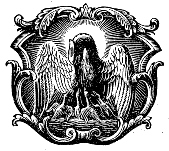
|
|
|
|
Human Development is the Heart of Christmas
|
SUMMARY & OUTLINE
SUMMARY
According to the Judeo-Christian tradition, human development started with the creation of the first human couple, Adam and Eve, as a communion of persons endowed with the gift of love and the gift of life. Both man and woman
were created in the image of God (imago Dei) and both were destined to take good care of each other and the entire creation. But they instead decided to do things their own way and ended up creating patterns of domination - of each other and of nature - that persist even today. The Hebrew Bible, also known as the Old Testament, is the "story" (not "history") of the tense interaction between God and people longing for, and running away from, their original unity and innocence.
For Christians, the decisive turning point in this process of human development was the birth of Jesus of Nazareth in or near the town of Bethlehem of Judea, about 5 kilometers SW of Jerusalem, circa 4 BCE. Each human being is unique, but Christians believe that Jesus is the consummated "Human Being" and the model of what God wants every human being to be. This is what Christians are celebrating during this beautiful season of Christmas: in Jesus we have a model of what we are, and his life is like a roadmap to actually "become what we are." This is the kind of human development that can become sustainable and enable humanity to become a communion of persons living in harmony with the human habitat.
OUTLINE
The outline for this issue is as follows:
Page 1. Editorial Opinion ~ Sustainable Human Development started in Bethlehem
Page 2. First Steps toward a Theory of Shit, by Ina Praetorius.
Page 3. Gender and Theology in Africa Today, by Mercy Amba Oduyoye
Page 4. What Every Environmentalist Needs to Know About Capitalism, by Fred Magdoff and
John Bellamy Foster
Page 5. Heresy and the Creation of Monsters, by Judith A. Curry
Page 6. The Economics of 350, by Frank Ackerman et al
Returning to 350 ppm CO2, by Paul Baer
Page 7. Concentrated Wealth and the Purchase of Political Power: Democracy's Death Spiral,
by Charles Hugh Smith
Page 8. Patriarchy and Violence, by Robert G. Hewitt
Page 9. The "Good New Days" in a Non-Growing Economy, by Rob Dietz
This issue also includes updates of the following supplements:
Supplement 1: Advances in Sustainable Development, is a monthly snapshot of significant recent contributions to in-depth understanding of the sustainable development process in general and integral human development in particular. This supplement includes the following items:
1. Suggestions for Prayer, Study, and Action
2. News, Publications, Tools, and Conferences
3. Advances in Sustainable Development
4. Advances in Integral Human Development
5. Advances in Integrated Sustainable Development
6. Recently Launched Games and Simulation Tools
7. Visualizations of the Sustainable Development Process
8. Sustainable Development Modeling and Simulation
9. Sustainable Development and the International Community
Supplement 2: Directory of Sustainable Development Resources is an annotated directory of online resources on sustainable development and related issues. Links are provided to selected online content in the following categories:
1. Population and Human Development
2. Cultural, Social, and Security Issues
3. Financial, Economic, and Political Issues
4. Ecological Resources and Ecosystem Services
5. Renewable and Nonrenewable Energy Sources
6. Pollution, Climate Change, and Environmental Management
7. Land, Agriculture, Food Supply, and Water Supply
8. Current Outlook for the Planet and Human Civilization
9. Transition from Consumerism to Sustainability
Supplement 3: Sustainable Development Simulation (SDSIM) - General Description is the documentation and user's guide for SDSIM Version 1.3, organized as follows:
1. The Sustainable Development Paradox
2. Sustainable Development Simulation Scenarios
3. SDSIM Version 1.3 Causal Loop Diagram
4. SDSIM Version 1.3 Model Diagram
5. SDSIM Version 1.3 Mathematical Formulation
6. SDSIM Version 1.3 User Interface
7. SDSIM Version 1.3 Simulation Results
8. SDSIM Version 1.3 Comparative Analysis & Synthesis
9. SDSIM Version 1.3 Limitations & Pending Issues
|
Editorial Opinion
Sustainable Human Development started in Bethlehem
|
On 25 December, Christians all over the world celebrate Christmas, the (presumed) anniversary of the birth of Jesus of Nazareth. It is lamentable that nowadays, even among devout Christians, celebrating Christmas often degenerates into a consumerist frenzy. The use and abuse of credit cards may bring comfort to merchants but obscures the real significance of the feast for those who confess the Christian faith. For they believe that this was the blessed event of God assuming human nature and abiding in human flesh (John 1:14): God becoming human so that humanity can be divinized. It is hereby proposed that sustainable human development actually started when this baby was born about 2014 years ago.
Sustainable Development
It is important to clarify the meaning of the terms "sustainable development" and "sustainable human development." The term "sustainable development" was coined by the Brundtland Commission in the landmark report Our Common Future, 1987. In this report, sustainable development was defined as "development that meets the needs of the present without compromising the ability of future generations to meet their own needs." Many consider Rachel Carson's Silent Spring, published in 1962, as a turning point in the understanding of the interdependence between humanity and the human habitat. Others consider the Limits to Growth study by Donella Meadows at al, initially published in 1972, as most important in that it was based on computer simulations that calculated the socio-economic impacts of overshooting the planet's capacity to provide material resources; a capacity that had been considered to be a "free lunch" by the classical (Adam Smith, Thomas Maltus, and others, late 1700s and early 1800s) and neoclassical (Henry George, John Maynard Keynes, and others, late 1800s and early 1900s) schools of capitalist economics.
In the early 1800s, James Maitland (Lord Lauderdale) was the first to recognize that natural resources have an intrinsic value that should be taken into account; else, he argued, natural resources will be exploited to the point of being unable to sustain the human population, and human civilization will collapse. This became known as the "Lauderdale paradox." Karl Marx, in the mid-1800s, recognized the wisdom of Maitland's work, emphatically stating that "the earth is the reservoir, from whose bowels the use-values are to be torn," and arguing that these use-values (as opposed to
exchange-values) and even more fundamental for the welfare of humanity than the value added by labor. But Marx made the fatal mistake of focusing on materialistic values at the expense of spiritual values; and his Communist Manifesto (1848) eventually led to Communist revolutions that created "dictatorships of the proletariat," with disastrous consequences that are now history.
Capitalism gradually became the dominant economic system, especially during the second half of the 20th century and even more so after the demise of Soviet Communism (1989). Such dominance has become worldwide via globalization. But the Lauderdale paradox still applies, which means that the accumulation of exchange-value (as measured by GDP) continues to grow exponentially and still treats natural resources as "externalities" (i.e., "free lunches"). It follows that environmental degradation is also growing exponentially, and natural resources depleted at an increasingly increasing rate. As Henry George pointed out in 1904, "nothing can come out of nothing." When all the natural resources become insufficient to support human life, what are we going to do? And yet,
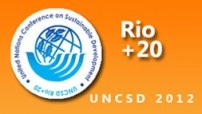
United Nations Conference on Sustainable Development 2012
Source: UNCSD2010
|
Capitalism (often with some politically correct but ineffective constraints) insatiable continues to seek the accumulation of wealth for the rich and very rich at the expense of nature and at the expense of the poor and very poor. Various forms of "capitalist sustainable development" are little more that exercises in denial; and alternative economic systems, such as proposed by (among others) the Center for the Advancement of the Steady State Economy (CASSE) and the Center for the Study of Democratic Societies (CSDS) are not attractive to Wall Street and the dominant economic elites.
This is where we are in sustainable development. Capitalists want to keep going for short term profits no matter what the long term social and ecological consequences might be. With extreme socialism discredited, most socialists are becoming capitalists ("market friendly") under various disguises. An effective synthesis of Capitalism and Socialism is yet to appear in the horizon. This is not a promising state of affairs as we enter the second decade of the 21st century. For more on the recent evolution and current outlook on sustainable development, click here, here, and here.
Sustainable Human Development
In the preface of a recently published book, The Ecological Rift: Capitalism's War on the Earth, the authors argue that it is time for a new "Holoanthropocene - an epoch of the "New Whole Human" based on transcending the alienation of humanity and nature." Five hundred pages later, they conclude with this sentence: "There is only one future: that of sustainable human development." Absolute agreement. But ... how can we best pursue the advent of the "Holoanthropocene"?
The Human Development Report (HDR) published annually by the United Nations is a significant contribution to building this future. It is now generally recognized that human development is the core of sustainable development. The 20th edition of the report, entitled The Real Wealth of Nations: Pathways to Human Development was released 4 November 2010. Starting in page 46, there is a section on "the puzzle of economic growth and human development" in which three findings are reported based on calculations of the Human Development Index (HDI):
- Economic growth and human development do not always coincide
- Strong relationship between economic growth and aggregate HDI growth (longevity+education+income)
- Weak relationship between economic growth and nonincome HDI growth (longevity+education)
Granted that longevity, education, and income are necessary factors of human development, they are not sufficient for people to reach the level of psychological and spiritual maturity that is required to overcome resistance to change and make decisions taking into account the common good. Specifically, the HDI does not include human development in the sense of people reaching
|
"The Human Development Index (HDI) is a summary measure
of human development. It measures the average achievements in
a country in three basic dimensions of human development: a
long and healthy life, access to knowledge and a decent standard
of living. The HDI is the geometric mean of normalized indices
measuring achievements in each dimension."
Human Development Report 2010, page 216.
|
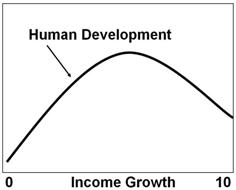
Hypothetical relationship between income growth and human development, drawn free hand on a 0-10 scale where zero is abject poverty and 10 is extravagant affluence. It is by no means implied that all the rich and very rich are crooks, or that all the poor and very poor are unable to reach wisdom. But the concave shape of the curve seems reasonable for Homo sapiens sapiens in general.
|
the upper echelons of Maslow's hierarchy of needs. Understood in this integral sense, human development probably would decline after a certain tipping point of affluence is reached. A hypothetical, hand-drawn relationship between economic growth and integral human development might look as shown here ... 
It is recognized that the HDR and the HDI are worked out in a context that is bounded by the realities of the current international situation and the data that is available in the UN statistical database. These data are undoubtedly the best available. The geometric mean that is used for HDI calculations is the appropriate algebraic procedure, as it is a matter of averaging data points on proportional growth. Careful study of the HDR and HDI is a must for anyone seriously interested in sustainable human development. Nevertheless, the transition from consumerism to sustainability will require a critical mass of "global citizens" who have reached a fairly high degree of self-determination, personal wisdom, and social responsibility. Whether the human development model used is Jung's individuation process, or Maslow's self-actualization level, or Deci & Ryan's Self-Determination Theory, let alone more spiritual methods such as the Spiritual Exercises of St. Ignatius Loyola, it is clear that none of these methods can work under the current constraints of "business as usual."
Referring to organized religion, Karl Marx correctly pointed out that religion is the opium of the people; but then he threw the baby out with the bathwater by reducing Homo sapiens sapiens to homo economicus. The inevitable transition from consumerism to sustainability will require homo economicus to become both homo solidarius and homo ecologicus. Again, how can we best facilitate the advent of this kind of human development?
A Christian Path to Sustainable Human Development
According to the Judeo-Christian tradition, human development started with the creation of the first human couple, Adam and Eve, as a communion of persons endowed with the gift of love and the gift of life. Both man and woman were created in the image of God (imago Dei) and both were destined to take good care of each other and the entire creation. But they instead decided to do things their own way and ended up creating patterns of domination - of each other and of nature - that persist even today. The Hebrew Bible, also known as the Old Testament, is the "story" (not a "history" to be understood in a literalist way) of the tense interaction between God and humans longing for, and running away from, their original unity and innocence.
For Christians, the decisive turning point in this process of human development was the birth of Jesus of Nazareth in or near the town of Bethlehem of Judea, about 5 kilometers SW of Jerusalem, circa 4 BCE. Each human being is unique, but Christians believe that Jesus is the consummated "Human Being" and the model of what God wants every human being to be. This is what Christians are celebrating during this beautiful season of Christmas: in Jesus we have a model of what we are in potentia, and his life is like a roadmap to actually "become what we are." It is the roadmap of an inner journey during which each person must make some hard choices pursuant to personal integration or disintegration, self-determination or conformism, solidarity or self-interest, sustainability or consumerism, disciplined spirituality or indulgence of bad corporal and mental habits. This process of learning to make choices is the kind of human development that can become sustainable and enable humanity to become a communion of persons living in harmony with the human habitat.
It is hereby proposed that sustainable human development actually started when a baby was born to poor homeless parents in the outskirts of Bethlehem. The name "Bethlehem" probably means "House of Lahmu and Lahamu," a pair of Mesopotamian agricultural deities. This may be significant in that Mesopotamia was the cradle of human civilization, and agriculture provides the most basic raw materials for sustainable development ("all flesh is grass", Isaiah 40:6).

Silver star marking the place where Jesus was born according to Christian tradition.
Source: Wikipedia
|
The name of the town is now Bayt Lahm, and it is located about five kilometers SW of Jerusalem in what is now the occupied West Bank. His first home may have been a cave or a barn, and his first crib may have been a pile of hay. This baby was born in utter poverty and obscurity, and his devout Jewish parents wouldn't know how to spell "consumerism."
The organized forms of Christian religion would come later. The temples and cathedrals with altars made of solid gold would come
later. The ecclesiastical attachment to money and honors would come later, and eventually degenerate into abominations like the medieval witch hunts in Europe, the religious wars, the forced "evangelization" (and even extinction) of indigenous populations, the slave trade across the Atlantic, ethnic cleansing of Jews and other minorities and, nowadays, the globalization of capital accumulation tightly coupled with human exploitation and ecological devastation. Is this what "Christendom" is all about? Perhaps it is, in the sense of being the theologically rationalized continuation of the Roman empire; but this is not what Jesus of Nazareth was about. Deep down, people know that, and this is the reason why so many Christians remain faithful.
The mission of the baby born in Bethlehem was to be the "Human Being" (the "Son of Man" in the language of his Jewish culture) and to show the way to full human development (the "Kingdom of God" within) for every human being willing to follow the straight and narrow path; the path that every human being must travel even if there is pain and suffering along the way. "Jesus shows us something of what it means to become human, but not enough to keep us from having to discover our own humanity. We must weave the story, and for each of us the story will be unique." (Walter Wink, The Human Being, Fortress Press, 2002, page 139)
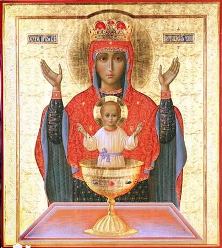
Mary, Mother of God
The iconographer (Eastern Orthodox, name unknown, circa 1300) obviously wanted to portray the deep eucharistic meaning of the incarnation. But there may be more. Is Mary of Nazareth the first Christian priest?
|
Christmas is a good time to reflect about the challenge of human development. It is also a good time to reflect about the intersection of religion (including the undeniable influence of organized religion) and sustainable human development. It must be a reflection on inclusiveness. This inclusiveness is present even in archaic religious dogmas as well as in priceless inspirations of religious art. Indeed, the star of Bethlehem is encapsulated in religious dogmas and religious art, but still needs to be liberated from boundaries of exclusiveness rooted in ancient prejudices and unhealthy mental habits. The essence of human development is to bring about this liberation, in each human being and in the human community worldwide. Human development is about allowing the star of Bethlehem to shine in full splendor! However, there are many Christian religious symbols that actually make the star invisible, or at least very hard to see; and the star sometimes seems to disappear during the journey, but we must keep walking in the dark like the Magi coming from the East. (Matthew 2:9-10)
The integration of opposites (male/female, light/darkness, good/evil, ego/shadow, love/hate ...) is no longer just for the few who can afford psychoanalysis. A globalization of psychological human development is indispensable to overcome structures of domination that prevent the globalization of human and ecological well-being.
"We recognize the negative side of the Human Being Archetype in a kind of spiritual rigidity, a fear of risk and exploration, a censorious attitude toward others that sin, and a fragile hold on the faith that is threatened by those who deviate from some norm. It is manifest in those who, mistaking nonviolence as nonresistance, acquiesce in evil rather than risk controversy.... This false notion of the Human Being tolerates sentimental pictures of Jesus in church and second-hand hymnody. It is a highly personal form of pietism that lacks connection with the needs of the social world, and that represses the shadow rather than attempting to integrate it. It fosters theological vigilantes who act as watchdogs for what they believe to be heresy, and who are, as I write, tearing denominations apart over their rejection of homosexuals.... The lust for spiritual power over others seduces some to identify their egos with God. The lowliness of the Humanchild who has nowhere to lay its head is a timely and much-needed corrective."
Walter Wink, The Human Being, Fortress Press, 2002, pages 116, 126-127.
|
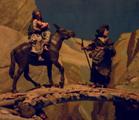
Flight into Egypt
|
If this is so for those who lust for spiritual power over others, imagine those who lust for worldly gratifications - money, honors, the lust of the flesh, the lust of the eyes, and the pride of life (1 John 2:15-16). During this Christmas season, Christians should pray for understanding and tolerance. Those who belong to other religious traditions should pray likewise during their special observances. We all have to leave behind this crazy world of unsustainable justice and oppression, and eventually return to allow the Humanchild in each human being to grow in wisdom and stature, and in favor with God and all the people. (Luke 2:52)
Human development is the heart of Christmas. It is so individually and collectively, for authentic human development always leads to the kind of social action that seeks a fair balance between self-interest and the common good. This is the only way to resolve the sustainable development paradox. But is requires making an unavoidable choice:
|
"Today the unknown seeks the known.
What I am willed to ask,
your own will has to answer.
Child, it lies within your power of choosing
to conceive the child who chooses you."
W. H. Auden,
Christmas Oratorio, 1944
|
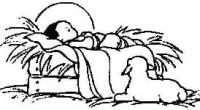
|
|
|Back to SUMMARY & OUTLINE|
Page 1
Page 2
Page 3
Page 4
Page 5
Page 6
Page 7
Page 8
Page 9
Supplement 1
Supplement 2
Supplement 3
PelicanWeb Home Page
|
|
|
"We are but the spoons in God's kitchen."
Carl Jung, 1875-1961
|
|
Page 1
|
|
FREE SUBSCRIPTION
|
![[groups_small]](groups_small.gif)
|
Subscribe to the
Mother Pelican Journal
via the Solidarity-Sustainability Group
Enter your email address:
|
|
|
|